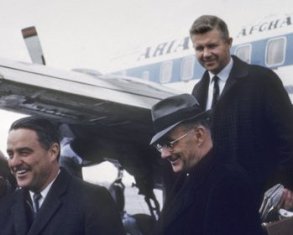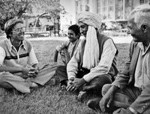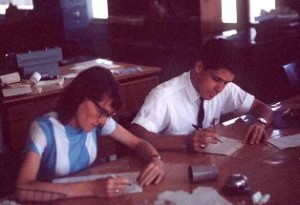Talking with Fran and Will Irwin about their book: The Early Years of Peace Corps in Afghanistan: A Promising Time
What happens with two young kids who meet, say, in a place like Kabul, Afghanistan, when they are 23 or 24, as Volunteers in the Peace Corps? Let’s say they’re PCVs helping to develop a city newspaper; let’s call it the Kabul Times, and then they fall in love. (Sounds like a movie, right?)
They finish their tour and marry, and have long and productive years together, one with a career as an NGO environmental policy analyst (that’s the girl), and the boy, well, he becomes a lawyer (don’t they all?), and then (of course) next he is a judge. (With every sentence this sounds more like a movie, or better yet, a Netflix film.)
They retire and are living happily ever after in leisure. Then they happen to go to a Peace Corps Conference, let’s say the 50th Anniversary of the agency. They hear PC/Afghanistan’s first director Bob Steiner tell how he was raising chickens in Vermont when he got a call from Shriver’s office, and learn that he has not written down his stories. They run into the old gang of PCVs from Kabul and listen to more stories and tell tall tales, You remember the time, Will, when a bunch of us went to Bamiyan and you took Fran exploring the Red City and the Buddhas and . . . ” (You get the picture?)
So, on the way home the happily retired couple, in the quiet of their car, driving
back to Bethesda, Maryland, where they live, are both silently thinking: Hey, wouldn’t this make a great book!
And indeed it would be.

So, they email Marian Haley Beil and ask about producing a Peace Corps Writers book that they might entitle The Early Years of Peace Corps in Afghanistan: A Promising Time. And the next thing we know we have the book, published this February, 2014, by Peace Corps Writers and written by Fran (Hopkins) Irwin and Will Irwin, those young kids who years ago fell in love in Kabul.
Lets step back in time for a moment and see if we can reconstruct that time when they were kids and had no idea what their lives would become.
But first some background.
Fran Hopkins got her B.A. in history at the College of Wooster in Ohio in 1963 and then earned her M.A. in international relations in Boston at the Fletcher School of Law and Diplomacy in 1964 and decided to become a PCV. She says, “I listed Afghanistan, Nepal, and Peru as countries I’d like to serve in, and unlike quite a few Volunteers invited to the Afghanistan program, I at least knew where the country was located.”
Will Irwin was a little behind Fran in years. He was in college, getting his A.B. in American culture at the University of Michigan and wouldn’t graduate until December of ’65. But by March of ’66, he was in Afghanistan for In-Country Training.
Let’s let the two of them tell their story.
.
We’ll begin by asking Fran how she started working for a newspaper in Kabul, not a typical Peace Corps assignment as we know.
Fran: The timing was right. Sabahuddin Kushkaki, who had gotten his journalism training in the U.S., at Nebraska and Syracuse, had started the Kabul Times as the Afghan government’s English-language newspaper just a couple of years earlier. He asked Bob Steiner for a Volunteer journalist to work on the paper which was trying to reach the international community as well as Afghans who knew or were learning English. I had been an editor on my school papers in high school and college. I had enough experience to help the staff get the paper out every day.
.
What did you do?
Fran: The Kabul Times was initially a four-page daily (except Friday) with an editorial staff of about half a dozen. That meant I was soon involved in many aspects. I turned wire stories from China, France, Germany, the Soviet Union, and the U.S. into articles appropriate for a non-aligned country. One of the ways I improved my Dari beyond formal lessons was by typing (and editing in the process) as counterparts translated the local news from Dari into English. After finishing with the headlines and layout, I often went out to report features in the afternoon. In my third year, I put together a stylebook and also worked on a first Kabul Times Yearbook. It included stories about each province. Many of those drew on a three-week reporting trip I made with a Times’ colleague and others by Landrover around the country. That was a highlight of my three years in Afghanistan.
How did Will get involved with the Kabul Times?
Fran: Will arrived with Group VIII in March 1966. I was looking for Volunteers who might help out on the side of their teaching jobs and perhaps replace me at the Times. I was due to leave in June but was thinking about extending.
.
Okay, Will, how do you end up in Kabul in the first place?
Will: Mountains! I had seen slide shows of the expeditions of the Iowa Mountaineers growing up in Iowa City. My dad had dedicated his book on the literature of mountaineering to me. I wrote on my application that I wanted to go to a mountainous country.
.
And when you arrived you were assigned to the Kabul Times ?
Will: No. I was assigned to teach English to classes of air traffic controllers, radio mechanics, meteorologists, and other students at the United Nations International Civil Aviation Organization (ICAO) school, but it wasn’t long before I began to help produce the Kabul Times weekly student page for use by Afghan and Peace Corps Volunteer teachers of high school English. Once my position at the ICAO school was filled by a Volunteer from the group that arrived in early 1967, I went to work full-time at the paper.
.
Did the two of you complement each other at the newspaper, Will?
Will: Well, we overlapped full-time there officially perhaps only four months, but I began spending much of my time outside of class there before that. We worked on some of the same projects like the yearbook and the stylebook. I brought my experience teaching to taking the lead on the student page. One of fun things I did was create crossword puzzles for that page. I used my Dari in doing some marketing to schools and other potential subscribers in both Kabul and the provinces.
.
So what happened to Fran and Will after the Peace Corps?
Well, they were married in August of ’68 and Will went ahead and got his law degree at the University of Michigan, finishing in 1970. Fran, who had been reporting for the Cleveland Plain Dealer since she returned to the U.S., helped edit Afghanistan: Some New Approaches with the University of Michigan’s Center for Near Eastern and North African Studies and also put out a newsletter for the international office. After law school, they went to Germany where Will researched water law and Fran did research for the International Union for Conservation of Nature and Natural Resources. The next stop was Vermont, where their daughter Amanda was born. Will worked for the state of Vermont Water Resources Board and Fran for the non-profit Vermont Natural Resources Council.
In 1973, they moved to Washington, intending to stay a few years. Will directed research projects at the Environmental Law Institute before being appointed an administrative judge at the U.S. Department of the Interior in 1978, deciding appeals from Department decisions involving surface mining, natural resources and environmental law. He retired in 2006.
Fran spent her career as an environmental analyst and writer with non-governmental organizations including The Conservation Foundation, World Wildlife Fund, and World Resources Institute, where she continues to consult.
And then they went to the 50th Anniversary of the Peace Corps in Washington and decided to write a book about the early years of the Peace Corps in Afghanistan.
So, I asked them.
.
What about your book?

Shriver, bottom left, and Steiner, top right, arriving in Kabul in January 1964
Fran sums up. Our book is the story of how — under the guidance of first director Bob Steiner — the Peace Corps in Afghanistan grew from the first small group of nine Volunteers that arrived in 1962, limited by a skeptical Afghan government to serving in Kabul, to over 200 Volunteers serving in most provinces by mid-1966. It tells how the program developed during the rapidly changing circumstances of that brief period. It is based on extended interviews with Steiner, contributions of Volunteers and other staff, and newsletters and 80 pages of contemporaneous writing by Volunteers lost in the “gray literature” of newspapers and newsletters. The book includes two dozen photographs and an extensive listing of source materials about Afghanistan, including other material about Peace Corps in Afghanistan.
Will: What happened is that at the 50th in 2011 we heard Bob Steiner tell some great stories about how the program got started in Kabul. We asked him if he’d written them down and when he said he hadn’t gotten around to it, we offered to help and he accepted. We were delighted — and so was his family, who had been encouraging him.
Fran: We, of course, had been seeing the flood of articles and books about Afghanistan since 9/11 but they included very little about the country we knew. We wanted to share what seemed a promising time in Afghanistan and leave a record of it. The new constitution providing, at least on paper, equal rights to men and women had been adopted only a month before I arrived. More women were at the university and in government offices. The first prime minister not a member of the royal family was taking a few steps toward more balanced development of health and education across the country. Half the Volunteers in Group IV of which I was a member were immediately assigned to work in provinces around the country rather than limited to Kabul. A new Kabul University campus funded by the U.S. had just opened. The Soviet-built Salang tunnel reduced the trip north from Kabul through mountains to hours from days. In the first winter, I kept my hands warm around a tea cup as we burned the newsletters from embassies in the stove at the Times. Volunteers used quite effective sawdust-burning stoves at home. The second year all the government papers and presses moved to a heated building. However, the seeds of later challenges were being planted. Students demonstrated as the first parliament elected under the new constitution met, and demonstrations continued to grow as Islamist and communist groups formed.
.
Where did you find material for your book beyond the interviews with Bob Steiner?
Will: We chose to write about the first four years because those were the times we knew. We enjoyed getting in touch with the staff and Volunteers, some we knew and some we had not known. We got into our boxes and found newsletters from the program. I went to the National Archives. I located a set of minutes of a meeting in which the Afghanistan program was proposed, which solved one question no one had been able to answer. I also found completion-of-service reports for the first four groups. I am still looking for a copy of the evaluation of the Peace Corps/Afghanistan program written by Leslie Hanscom in 1966, which is cited as iconic. We also found that the Peace Corps Digital Library is becoming a useful source as it adds more material.
Fran: We are now more aware how different our experience of the country was than that of Volunteers who came later. Not only were circumstances in Afghanistan different — the political situation, for example, and the famine that developed — but they were different at home. Vietnam and drugs were issues that were just beginning to concern early Volunteers. Drugs did not even come up in the first group’s training.
.What are some of the other RPCV books about Afghanistan?
Fran: There is the film Once in Afghanistan and the recent Peace Corps Writers book by Susan Fox on the Little Women of Baghlan. Both tell about health programs at the end of the 1960s. John Sumser has written Land Without Time about his experience in the last years. It bookends David Fleishhacker’s Lessons from Afghanistan, reflecting his experience in the first group. We are working with Friends of Afghanistan to get up on its website the links to pieces of the story — some of it long lost in newspapers and newsletters — of how 1,650 Peace Corps Volunteers served in Afghanistan over 17 years. Of course, some of the important stories — mostly yet to come — will be those of Volunteers who went back to Afghanistan after 2001 or whose sons and daughters served in Afghanistan over the past decade.
.
Anything you would like to add, Will?

- The Peace Corps operations in Afghanistan were terminated after the Kabul government was overthrown by the Khalq revolution in 1978.
Will: Just our thanks to you and Marian for all your years of encouraging Peace Corps Volunteers to tell their stories. There’s no reason you should remember me, but when you gave a presentation in Washington – I don’t know, ten or twelve years ago – I told you I was thinking about a Hemingway-like story of my fishing trip into the Andarab valley of the Hindu Kush. Great, you said, do it! Well, I think what we’ve done is a much better story than that one, but your support was essential to getting it done. Thanks very much.

That interview was wonderful. Together with the book itself, they brought to life the experiences so many of us had in that country, so lively and full of hope as Fran and Will describe it and the Peace Corps effort. I was Bob Steiner’s successor as Country Director, and indeed things started to get considerably more complicated, both with the numbers of volunteers, the side-effects of the Viet Nam war, illnesses, and the Great Powers’ struggle for the soul of Afghanistan. My wife, Janice Minott, has written her impressions as a memoir LETTERS FROM KABUL, published by Stafford Press and available from Amazon. As she states, it is the view of a staff wife with 3 children, living in almost a parallel universe to the PCV’s and PC Staff. It’s a goof complement to the Irwin’s book.
May 20, 2024
I was a PCV in Afghanistan Group VIIIB (the nurses). I served a year in Kandahar and a year in Kabul. I married a volunteer from group X . Walter Blass held our wedding reception in his home.
I loved reading Will and Fran’s book and can’t thank them enough for publishing it!
Please let them know I have benefited from reading it. Thank you.